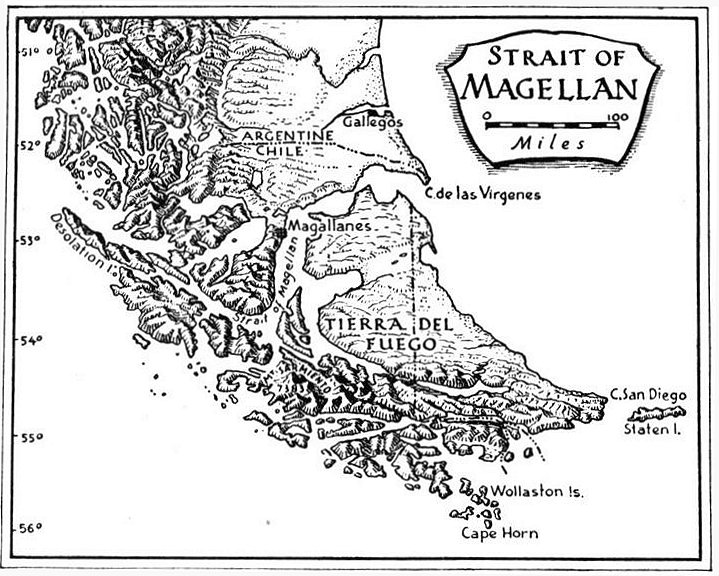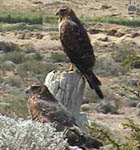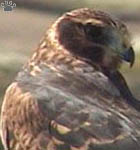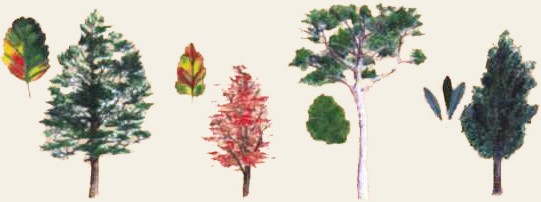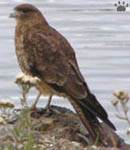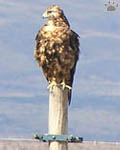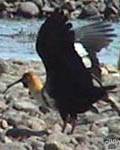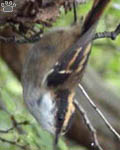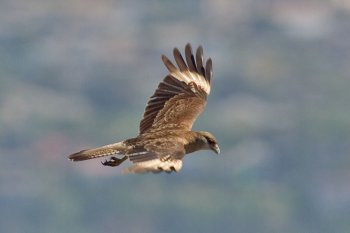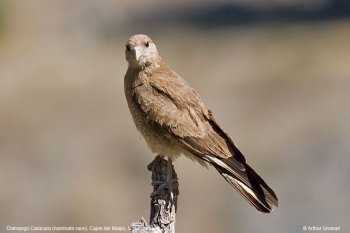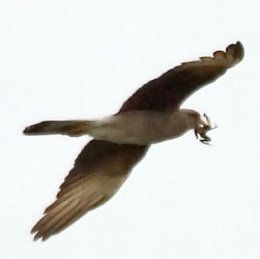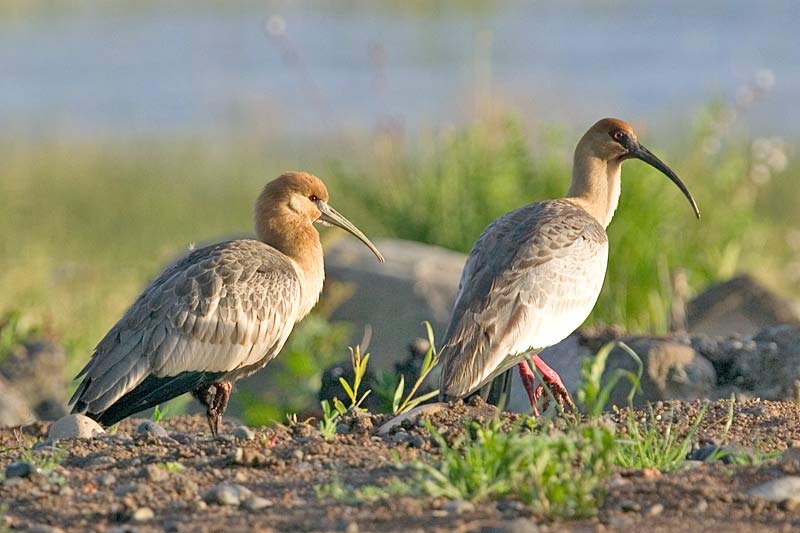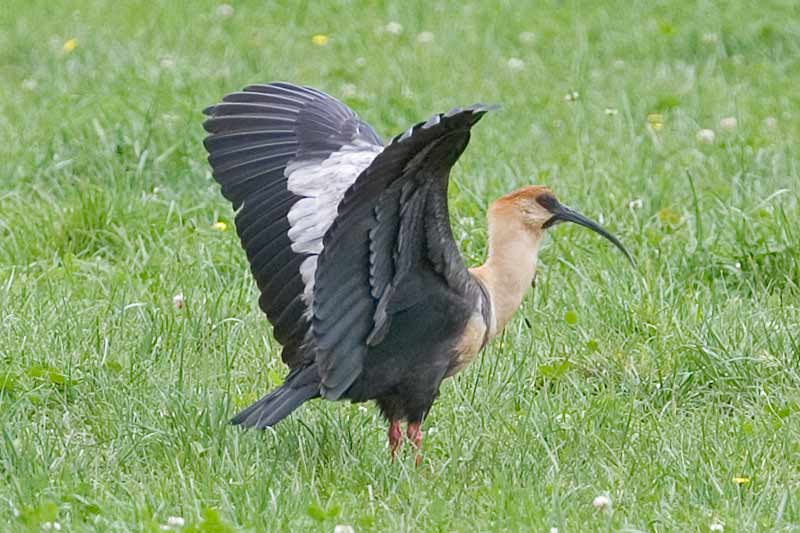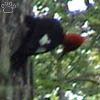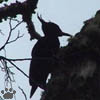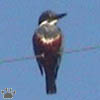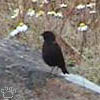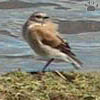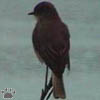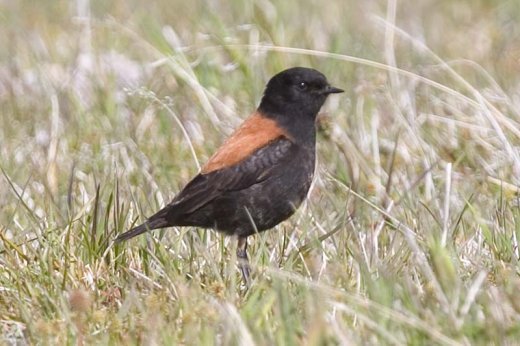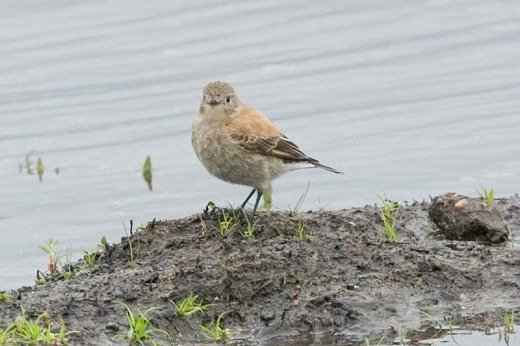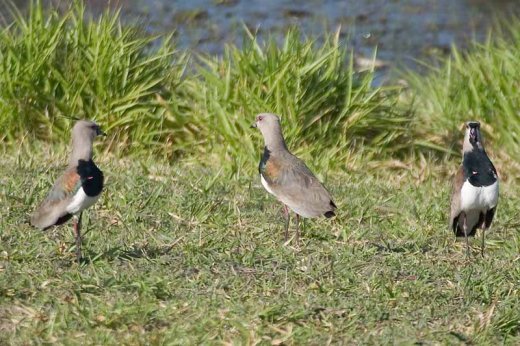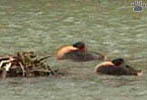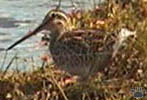From a rearranged translation of Vladimir
Dinets original pages to norwegian,
with supplements.

Klikk på flagg for norsk versjon
Pages for Latin America
Terra del Fuego,
Tierra del Fuego and the Falklands are very different from other
Scotia Sea islands.
They have relatively mild maritime climate. Despite being cool and
windy places, they also have diverse flora and fauna.
Tierra del Fuego is particularly similar to mainland Patagonia.
This is not surprising: the Strait of Magellan is less than
1 km wide in
some places. The northeastern part of Isla Grande (the main
island) is relatively flat. The rest is a labyrinth of mountains,
fjords, and
rocky islets - a continuation of the Andes deeply transformed
by glaciation. Tides reach 15 m in some places. Strong tidal
currents
form highly productive intertidal zone where numerous invertebrates,
fishes, and birds find abundant food. |

Tidal current, Strait of Magellan. |

Aerial view of Isla Grande, Tierra del Fuego |
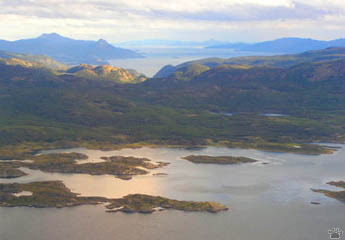 Aerial
view of Isla Navarino.
Aerial
view of Isla Navarino.
Cape Horn Islands are visible on the horizon
|
Flying
Steamer duck, Tachyeres patachonicus
The Flying Steamer Duck, Tachyeres patachonicus,
is a steamer duck. It is the most widespread steamer duck,
resident in southern Chile and Argentina, Tierra del Fuego and
the Falkland Islands. Its plumage is very similar to
the other three steamer ducks. It is the only steamer duck which
can fly, and the only one to occur on inland fresh
waters.
Steamer-ducks are so named because they run across the water
using their feet for propulsion and their wings as a
sort of splashing support as can be seen in photos 1 to 4. This
reminded early sailors of a paddle steamer.
Another distinguishing feature of the Flying Steamer-duck is
that it usually shows a long, up-curled tail when swimming.
This was noticeable on the bird in photo above.
Source:
different
Most previous observers agreed that steamingbirds power themselves
rapidly overt he surface of the water using
their feet and wings, producing substantial spray and turbulence.
Steaming birds attain estimated speeds of up to
40 km/hour, and one has seen birds steam without pause for 1
km or more. Steaming is used both for escape and
for attackd uring territorial encounters
Source:
"Mechanics of Steaming in Steamer-ducks" by Livezey
& Humphrey in Auk, April 1983. |
Eastern Isla Grande is covered with beautiful tallgrass steppe
inhabited by rheas, guanacos and geese.
The rest of the island is mostly forested.
Cinereous
Harrier, Circus cinereus
| |
|
|
|
Cinereous
harriers (Circus cinereus),
Rio Grande, Tierra del Fuego.
|
The Cinereous Harrier, Circus cinereus,
is a South American bird of prey of the harrier family. Its breeding
range extends from the
Tierra del Fuego through Argentina and Chile to Bolivia, Paraguay
and southern Brasil; and across the Andes north to Colombia.
The term cinereous describes its colouration. The male's plumage
is dark grey above with black wingtips and a white rump.
The underparts are pale grey, with a rufous streaked belly. The
female's plumage is brown above, with a white rump, and cream
coloured underneath, with a streaked belly similar to the males.
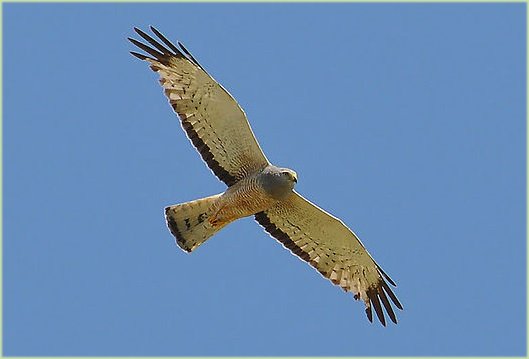 A
male Cinereous Harrier flying in Capão do Leão,
Rio Grande do Sul, Brazil.
A
male Cinereous Harrier flying in Capão do Leão,
Rio Grande do Sul, Brazil.
Photo: Cláudio Dias Timm |
The female is larger than the male with an average size of 46
cm compared to the male's 40 cm. The wingspan is 90–115 cm.
Since the 44.5 cm tail comprises about 56% of this raptor's total
length, this species ties with the Long-tailed Hawk as the raptor
with the longest tail relative to its body size.
This bird can be found in different open habitats, ranging from
lowland marshes to the Andean Altiplano at a maximum altitude
of
4500 metres. Like other harriers it nests on the ground. It is
usually considered to be sedentary.
Its diet is variable, due to a wide range and variety of habitats.
Its usual prey are small rodents and birds, reptiles, amphibians
and insects.
Source: http://en.wikipedia.org/wiki/Cinereous_Harrier
|
Lush forests of Tierra del Fuego are dominated by Southern beeches
(Notophagus).
Fall Colors are beautiful here. Thanks to the extremely wet climate,
these forests are broken in many places by lakes, peat bogs and fast-flowing
rivers.
Although most plants and animals here are the same as in nearby Chilean
Andes,
some are endemic or shared only with the Falkland Islands.
Notophagus
trees

Spark bumblebee
Bombus igneus,
Parque Nacional Tierra del Fuego. |

Notophagus forest,
Parque Nacional Queluat. |

Spark bumblebee
Bombus igneus,
Parque Nacional Tierra del Fuego. |

Nothofagus antarcticus,
Terra del Fuego. |

Nothofagus forest,
Terra del Fuego.
|

Nothofagus pumilio,
Chaiten, Chile |
|
|
Nothofagus, also known as the southern beeches,
is a genus of 36 species of trees and shrubs native to the temperate
oceanic to
tropical Southern Hemisphere in southern South America (Chile,
Argentina) and Australasia (east and southeast Australia, Tasmania,
New Zealand, New Guinea and New Caledonia). In the past, they
were included in the family Fagaceae.
The leaves are toothed or entire, evergreen or deciduous. The
fruit is a small, flattened or triangular nut, borne in cupules
containing two to seven nuts.
Nothofagus species are used as food plants by the larvae of
hepialid moths of the genus Aenetus, including Aaenetus
eximia and
Aenetus virescens.
Many individual trees are extremely old, and at one time it
was believed that some populations could not reproduce in present-day
conditions at the location where they were growing, except by
suckering (clonal reproduction), being remnant forest from a
cooler
time. It has since been shown that sexual reproduction may occur,
but distribution in cool, isolated high-altitude environments
at
temperate and tropical latitudes is consistent with the theory
that the genus was more prolific in a cooler age.

Antarctic
Beech, Nothofagus antarctica
Photo:
Wouter Hagens |
Antarctic Beech, Nothofagus antarctica (in Spanish
Ñire or Ñirre), is a deciduous tree or shrub native
to southern Chile and
Argentina from about 36°S to Tierra del Fuego (56° S).
The southernmost occurrence is on Hoste Island, making it the
southernmost trees on earth. It grows mainly in
the diminishing temperate rainforests.
It typically grows 10–25 m tall and has a slender trunk
with scaly bark. The leaves are simple and alternate, growing
2-4.5 cm long,
and often viscid, with a sweetly scented wax. The leaf color
is medium green, becoming yellow to orange in the fall.
They are broadly ovate to triangular, crinkly, rounded at the
tips, irregularly and minutely toothed. The flowers are inconspicuous
yellow-green catkins. The fruit is a 6 mm, very fragrant 4-valved
capsule containing three small nuts.
Lenga Beech , Nothofagus pumilio, (or Lenga) is
a deciduous tree or shrub in the Nothofagaceae family
that is native to the
southern Andes range, in the temperate forests of Chile and
Argentina to Tierra del Fuego, from 35° to 56° South
latitude.
This tree is in the same genus as the Coihue. It regenerates
easily after fires. The wood has good quality, moderate durable,
easy-to-work. It is used in furniture, shingles and construction
and sometimes as a substitute for American Black Cherry in the
manufacturing of cabinets.
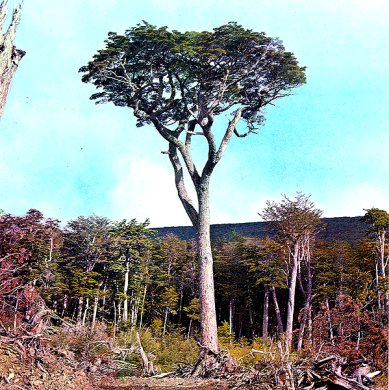 Magellan's
beech, Nothofagus betuloides
Magellan's
beech, Nothofagus betuloides
Photo: Jorge Vallmitjana |
Magellan's beech, Nothofagus betuloides, is sometimes
known by the common name guindo, is native to southern Patagonia.
In 1769 Sir Joseph Banks collected a specimen of the tree in
Tierra del Fuego during Captain Cook's first voyage.[1]
Nothofagus betuloides grows from southern Chile and southern
Argentina (40°S) to Tierra del Fuego (56°S), specimens
from the
southern forests resist temperatures down to -20°C. It is
found from sea level to 500 meters. It is an evergreen tree,
up to 25 meters, columnar appearance, in its natural environment
it tolerates cold winters and absence of heat in summer
Source: different Wikipedia
with the latin names |
Austral
sundew, Drosera uniflora

Dog orchid,
Bipinnula triangulatum,
Tierra del Fuego NP . |

Austral sundew, Drosera uniflora,
en innsektetende plante,
Parque Nacional Tierra del Fuego. |

Beech orchid,
Cavilea lutea,
Tierra del Fuego NP. |
Dog
orchid, Bipinnula triangulatum or possibly
White Dog Orchid, but have not been able to find any information.
Drosera uniflora, is a species in the carnivorous
plant genus Drosera that is native to southern Chile,
Argentina,
and the Falkland Islands. It was originally described in 1809
by the botanist Carl Ludwig Willdenow.
Beech orchid, Cavilea lutea, Not able to find
this one either. Information wanted. E-mail address on bottom
of page. |
Tierra del Fuego is a great place for birdwatching, especially
in October,
when summer migrants already arrive from the North, but wintering
Antarctic seabirds are still present.
Summer and fall months (up to April) are also great.
Chimango
Caracara, Milvago chimango
|
|
|
|
|
|
Chimango
Caracara,
Milvago chimango,
Ushuaia,
Tierra del Fuego.
|
Rufous-tailed
Hawk,
Buteo ventralis,
Lago Fangano,
Tierra del Fuego.
|
Black-faced
Ibis,
Theristicus melanopis,
Porvenir, Tierra del Fuego.
|
Thorn-tailed
Rrayadito
Aphrastura spinicauda,
Tierra del Fuego NP
|
The Chimango Caracara, Milvago chimango,
also known as Tiuque, is a species of bird of prey in the
Falconidae family.
It is found in Argentina, Brazil, Chile, Paraguay and Uruguay.
It is a vagrant to the Falkland Islands. Its natural habitats
are
subtropical or tropical dry shrubland, subtropical or tropical
high-altitude shrubland, temperate grassland, and heavily degraded
former forest. It is a commonly known fact that natives of the
region do not commonly waste gunpowder on Chimangos.
This bird is typically found at edges of water, in hills, in
fields, the latter especially if they are newly ploughed. An
example habitat
for this bird is in the La Campana National Park dry forest
in the low elevation hills of central Chile; in this location,
one of the
dominant trees is the endangered Chilean wine palm.
 Chimango
caracara, Milvago chimango - Overview
BBC Natural
History Unit
Chimango
caracara, Milvago chimango - Overview
BBC Natural
History Unit
http://www.arkive.org
|
Length: 37 to 40 cm. A typical Chimango has a mantle and back
edged with cinnamon brown feathers and white. Neck, chest, abdomen
and belly light brown. Head dark brown. It is the smallest variety
of caracara. Wings dark brown stripe and white in the basal
half of the primaries. The tail is light brown with dark brown
terminal band. Eyes are brown. Peak color based clearer. Legs
are light gray in the male and yellowish in the female.
Source: http://en.wikipedia.org/wiki/Chimango_Caracara
|
Rufous-tailed
Hawk, Buteo ventralis
|
The Rufous-tailed Hawk, Buteo ventralis, is a
species of bird of prey in the Accipitridae
family.
The
Rufous-tailed Hawk is found in southern Argentina and Chile,
including the entire region of Tierra del Fuego.
Its natural habitats are temperate forests, subtropical or tropical
dry shrubland, subtropical or tropical high-altitude shrubland,
and temperate grassland. .
Source:
Wikipedia
Buteo ventralis is endemic
to the lower Andes of Patagonia in southern Chile and Argentina,
where it is rare, occurring at naturally
low densities. No data is available regarding numbers or densities,
and there is no firm evidence of a decline, but its habitat
has
suffered extensive degradation and some authorities consider
that the total populations is unlikely to exceed 1,000
individuals
It
inhabits the ecotone between Nothofagus
forest and steppe grassland from sea level to at least 1,200
m
Major Threats: Its habitat has been negatively
affected by logging and overgrazing since the introduction of
sheep and cattle.
Source:
BirdLife International 2008. Buteo ventralis. In: IUCN 2011.
IUCN Red List of Threatened Species. Version 2011.2. <www.iucnredlist.org>.
Downloaded on 02 March 2012.
Pictures wanted! E-mail adress at bottom of page.
|
Black-faced
Ibis, Theristicus melanopis
The Black-faced Ibis, Theristicus melanopis,
is a species of bird in the Threskiornithidae family.
It is found in grassland and
fields in southern and western South America.
The nominate subspecies of the Black-faced Ibis is mainly found
in southern South America, ranging throughout most of southern
and central Argentina and Chile, where it occurs from sea-level
to an altitude of approximately 2,500 metres. It also occurs
very
locally in coastal Peru. While it remains fairly common in Argentina
and Chile, this subspecies has now been almost entirely
extirpated from the Peruvian part of its range.
The subspecies branickii is restricted to altitudes of 3,000
to 5,000 metres in the Andean highlands of Bolivia, Peru and
Ecuador.
It is generally uncommon, and formerly also occurred in Lauca
in far northern Chile.
It has a total length of approximately 75 centimetres. In the
nominate subspecies the head, neck and lower chest are buffish,
the
crown and nape are cinnamon, the upperparts and (often incomplete)
chest-band are grey, the belly and flight feathers are black,
and the wing-coverts are whitish (though not contrasting strongly
with the grey upperparts). The bill, throat-wattle and bare
skin
around the eyes are blackish and the legs are red. In the subspecies
branickii the throat-wattle is smaller, the bill is shorter,
the wing-coverts are greyer, the lower chest is paler and the
cinnamon on the crown and nape is brighter and more extensive.
Source: http://en.wikipedia.org/wiki/Black-faced_Ibis |
Ringed
Kingfisher, Megaceryle torquata
|
|
|
|
|
|
|
|
Birds
of Tierra del Fuego National Park, left to right: male and female
Magellanic
Woodpecker, Campephilus magellanicus,
Ringed Kingfisher, Megaceryle torquata, male and female
Austral Negrito, Lessonia rufa, Fire-eyed Diucon,
Xolmis pyrope,
and Southern Lapwing, Vanellus chilensis.
|
The Ringed Kingfisher, Megaceryle torquata, is a
large, conspicuous and noisy kingfisher, commonly found along
the lower Rio Grande
River valley in southeasternmost Texas in the United States through
Central America to Tierra del Fuego in South America.
The breeding habitat is areas near large bodies of water, usually
in heavily wooded areas where it finds a perch to hunt from.
It is mostly a sedentary species, remaining in territories all
year long.
It is 40–41 cm long, with deep blue or bluish-gray plumage
with white markings, a shaggy crest and a broad white collar around
the neck.
Its most distinguishing characteristic is the entire rufous belly,
which also covers the entire breast of the male. Females are more
colorful
than the male (i.e., reverse sexual dimorphism) and have a bluish-gray
breast and a narrow white stripe separating the breast from the
belly.
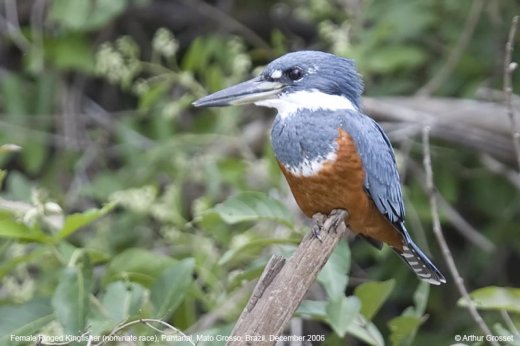 Ringed
Kingfisher, Megaceryle torquata
The
female seen here has a broad grey chest band above the
rufous belly
Ringed
Kingfisher, Megaceryle torquata
The
female seen here has a broad grey chest band above the
rufous belly
rather than the all rufous underparts of the male.
Photo:
©
http://www.arthurgrosset.com
|
These birds nest in a horizontal tunnel made in a river bank or
sand bank. The female lays 3 to 6 eggs. Both parents excavate
the tunnel,
incubate the eggs and feed the young.
It is often seen perched prominently on trees, posts, or other
suitable "watchpoints" close to water before plunging
in head first after its
fish prey. They also eat small mammals, insects, small reptiles
and berries.
Their voice is a loud, penetrating rattle given on the wing and
when perched.
Source: http://en.wikipedia.org/wiki/Ringed_Kingfisher |
Austral
Negrito, Lessonia rufa
The Austral Negrito or Patagonian Negrito, Lessonia rufa,
is a species of bird in the Tyrannidae family. It breeds
in Argentina and Chile, migrating
north as far as Bolivia, southern Brazil, Paraguay and Uruguay.
It is a vagrant to the Falkland Islands. Its natural habitats
are freshwater lakes and saline marshes.
It is found in open areas with short grass and is often near the
coast or lake shores. Very active, it forages for small insects
running
along the ground and sallying in the air. Much given to flicking
its wings and tail.
The male is all black except for its rufous-chestnut back. It
has a short black bill and black legs with a very long hind claw.
The female has a less chestnuty back, is brownish-grey below with
dark streaks and has two wing-bars. It is the female that
helps to separate this species from Andean Negrito, Lessonia
oreas, by being much lighter below, showing wing-bars and
having white at the edge of the tail.
Source: http://www.arthurgrosset.com
|
Fire-eyed Diucon, Xolmis pyrope
The Fire-eyed Diucon, Xolmis pyrope, is
a passerine bird of South America belonging to the tyrant flycatcher
family Tyrannidae.
It is usually placed with the monjitas in the genus Xolmis
but was sometimes placed in its own genus Pyrope
in the past.
It is 19-21 cm long. The upperparts are mainly plain grey. The
underparts are pale grey with white throat and undertail-coverts.
The eyes are bright coral-red, for which the bird is named.
It is found in central and southern Chile, southwestern Argentina,
and Tierra del Fuego. It is found in woodland, forest edge
and farmland and is normally seen perching on bushes or fences.
Vagrant birds have occurred just eastwards of Tierra del
Fuego in the Falkland Islands. |
Southern
Lapwing, Vanellus chilensis

The Southern Lapwing has red spurs at the bend of the wing which
are displayed
to rivals and enemies as part of the show of aggression. These
can be seen well
in the photo which shows the first part of an extraordinary
display.
This group of 4 birds advanced rapidly calling loudly with their
spurs showing
on a single bird who was presumably trying to invade their (co-operative?)
breeding territory.
Photo:
©
http://www.arthurgrosset.com
|
The Fire-eyed Diucon, Xolmis pyrope, is a passerine bird of
South America belonging to the tyrant
flycatcher family Tyrannidae.
It is usually placed with the monjitas in the genus Xolmis
but was sometimes placed in its own genus Pyrope
in the past.
It is 19-21 cm long. The upperparts are mainly plain grey. The
underparts are pale grey with white throat and undertail-coverts.
The eyes are bright coral-red, for which the bird is named.
It is found in central and southern Chile, southwestern Argentina,
and Tierra del Fuego. Vagrant birds have occurred just eastwards
of Tierra del Fuego in the Falkland Islands.
|
Many uncommon species can be found in coastal towns and along highways.
Other unusual things to see are albatrosses feeding in small inshore
bays,
parakeets in snow-covered forests, and ibises nesting in seabird colonies.
Unfortunately, there is a lot of habitat damage from introduced sheep,
hares, rabbits, and beavers.
Native culpeo fox has been largely displaced by introduced Patagonian
fox,
although the two species coexist well in mainland Patagonia.
Gray
Fox, Lycalopex griseus
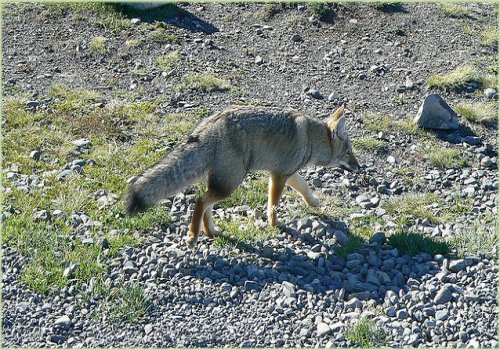 South
American gray fox, Lycalopex griseus
South
American gray fox, Lycalopex griseus
Photo: claudioruiz |
The South American gray fox, Lycalopex
griseus, also known as the Patagonian fox, the chilla,
or the grey zorro, is a species of zorro, the "false"
foxes.
The South American gray fox is found in the Southern Cone of
South America, particularly in Argentina and Chile. Its range
comprises a stripe, both sides of the Andes Mountain Range between
parallels 17ºS (northernmost Chile)
and 54ºS (Tierra del Fuego).
In Argentina, this species inhabits the western semiarid region
of the country, from the Andean spurs (ca. 69ºW)
to meridian 66ºW. South from the Río Grande river,
the distribution of the fox widens reaching the Atlantic coast.
In Chile, it is present throughout the country. Its presence
in Peru has been mentioned; to date, however, there has
been no confirmation of it. The South American gray fox was
introduced to the Falkland Islands in the late 1920s
early 1930s and is still present in quite large numbers on Beaver
and Weddell Islands plus several smaller islands.
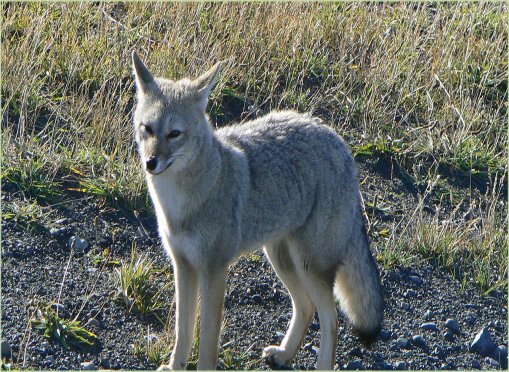 South
American gray fox, Lycalopex griseus
South
American gray fox, Lycalopex griseus
Photo:
claudioruiz |
The South American gray fox occurs in a variety of habitats,
from the warm, arid scrublands of the Argentine Monte
and the cold, arid Patagonian steppe to the forest of southernmost
Chile.
The South American gray fox is a small South American canid,
weighing 2.5–4 kg), and measuring 43–70 cm in length.
Its diet consists mainly of rodents, birds, and rabbits.
Source:
http://en.wikipedia.org/wiki/South_American_gray_fox |
There are a lot more birds down here in this end
of South America,
but let us cross the border to the Argentinian side of The Andes
and see what we can find there.
|
|
|
|
|
|
|
|
Birds
of Tierra del Fuego National Park, left to right: Long-tailed
Meadowlark, Sturnella loyca, (2 pictures), Great Grebe,
Podiceps major,
South American Snipe, Gallinago paraguaiae, Southern
House Wren, Troglodytes musicus, Black-chinned Siskin,
Carduelis barbata.
|
|






